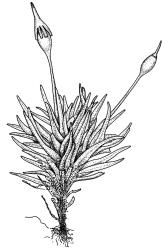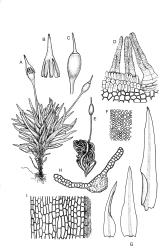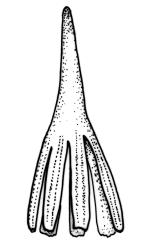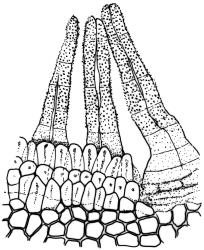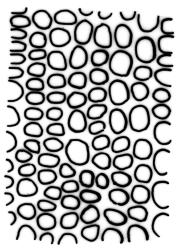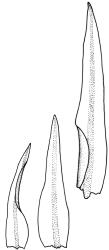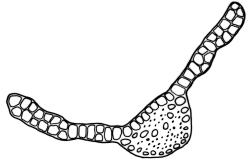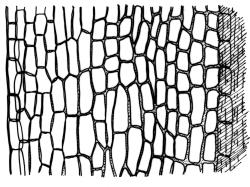- ≡ Brachysteleum australe Hampe, Linnaea 28: 209 (1856)
- ≡ Glyphomitrium adamsonii Mitt., J. Proc. Linn. Soc., Bot. 4: 73 (1859)
- = Ptychomitrium adamsonii (Mitt.) A.Jaeger, Ber. Thätigk. St. Gallischen Naturwiss. Ges. 1872–1873: 103
- = Orthotrichum hurunui R.Br.bis, Trans. & Proc. New Zealand Inst. 27: 436 (1895)
- = Grimmia barrii R.Br.bis, Trans. & Proc. New Zealand Inst. 35: 337 (1903)
- ≡ Ptychomitrium barrii (R.Br.bis) Dixon, Bull. New Zealand Inst. 3: 155 (1926)
- = Grimmia turneri R.Br.bis, Trans. & Proc. New Zealand Inst. 35: 336 (1903)
Plants forming cushions or low turves on rock, dark green or yellow-green above, brown or nearly black below. Stems c. 5–7 mm, usually branched by forking, in cross-section with a central strand, beset below with smooth brown rhizoids. Leaves ovate-lanceolate, entire, acute or rounded and sometimes ± cucullate at apex, concave and U-shaped in section, not plicate, c. 2–3.5 mm, becoming gradually larger towards stem apex; margins plane, bistratose; mid laminal cells mostly shorter than wide, oblate-elliptic, firm-walled, smooth, c. 6 × 9–12 µm, bistratose in large patches, usually becoming predominantly or wholly bistratose (visible under compound microscope in surface view or in cross-section) in the upper lamina (c. 1 mm from the apex) but occasionally with bistratose areas largely confined to the margins; basal cells oblong-rectangular, thinner-walled, and weakly inflated; alar cells not differentiated. Costa subpercurrent, occupying c. ⅙ the width of the leaf base, often lustrous abaxially when dry, in cross-section bulging on the adaxial surface (inadequately illustrated here), with median guide cells and two stereid bands, the adaxial cell layer approximately the size of adjacent laminal cells.
Autoicous. Perichaetial leaves somewhat enlarged but otherwise not differentiated. Perigonia on short branches among upper leaves. Setae erect and ± straight, c. 4–5.5 mm, rather thin (c. 0.1 mm diam.), yellow or yellow-brown, smooth; capsules ellipsoid or ovoid, erect, 1.0–1.5 mm; mouth transverse; exothecial cells firm-walled and irregular in outline, mostly elongate; stomata few and restricted to extreme capsule base; annulus strongly differentiated, vesicular, falling with the operculum or sometimes persistent at mouth; operculum long and finely rostrate from a low conic base, ± equal to the urn. peristome inserted far below the mouth and obscured at base; teeth orange, papillose-baculate above, smooth or nearly so near base, c. 150–180 µm, with a medial gap extending from base nearly to apex or sometimes split apically to form two, ± equal, filiform divisions. Calyptra mitrate but sometimes strongly split on one side with maturity, deeply lobed, plicate, covering about ½ the capsule. Spores c. 12–16 µm, thick-walled, finely papillose.
Lewinsky 1980, figs 1–11 (from Holotype of Brachysteleum australe and Lectotype of Orthotrichum hurunui); Buck et al. 2002, p. 104; Malcolm & Malcolm 2003, p. 56; Meagher 2017, fig. 2.
Ptychomitrium australe could, if sterile, be confused with Dicranoweisia antarctica, a species that also occurs on rock. However, the Ptychomitrium has a lustre of the costa which is distinctive and it is generally a smaller plant. Additionally the Dicranoweisia differs by having well-developed alar cells, and unistratose upper laminal cells with faint longitudinal striations. When fruiting the two would be unlikely to be confused.
Tridontium tasmanicum is a generally much larger plant growing in aquatic or near aquatic habitats. While some material, particularly if sterile, might be confused with Ptychomitrium, the upper laminal cells in Tridontium are invariably unistratose. Ptychomitrium lacks the intra-marginal border that normally characterises Tridontium.
The lustrous costae of P. australe could lead to confusion with smaller forms of Holomitrium perichaetiale, but the present species is invariably terrestrial while the Holomitrium is mostly epiphytic. The present species is autoicous with perigonia on short branches among upper leaves while the Holomitrium is pseudautoicous. The distinctive bistratose upper laminal cells of the Ptychomitrium also serve to differentiate it. When fruiting (the autoicous Ptychomitrium is usually found fruiting), confusion with Holomitrium seems very unlikely.
NI: N Auckland, including offshore islands (PK, HC, LB, GB, Waiheke), S Auckland (Whale I.), Gisborne (Hicks Bay, Waihau Bay), Wellington (Fitzroy Bay, Sinclair Head, near Cape Palliser, Turakirae Heads); SI: Marlborough, Canterbury, Otago (Weston, Kurow); Ch.
Anomalous. Tasmania*, mainland Australia (Qld*, N.S.W*, Vic.*). Recorded from W.A., A.C.T., and Lord Howe I. by Meagher (2017), who also recorded it from "tropical regions" including South Africa, New Caledonia, Vanuatu, and South America. Meagher considered it to be "a largely tropical to warm-temperate species that extends into cold-temperate regions."
Mostly on rock, but sometimes on thin humus or mineral soil over rock, and recorded once from a "clay bank" (Waihopai River). Although the associated rock type is often unrecorded in herbarium specimens, basalt and/or andesite and greywacke are the most frequently recorded. Ptychomitrium australe is a common species on basalt garden walls in Auckland City. In the north, P. australe frequently occurs in Metrosideros excelsa-dominated coastal forest but it also occurs in inland situations. The bulk of North I. collections are from N Auckland and Wellington L.D. On the South I. it is restricted to the eastern, drier regions, extending into the foothills of Canterbury L.D. Commonly associated moss species include Grimmia pulvinata, Syntrichia pagorum, and Tortula muralis. Occurring from near sea level (many localities) to 270 m (Peel Forest, Canterbury L.D.) but a single, aberrant collection (discussed below) is from 1830 m elevation in Marlborough L.D.
In the great majority of collections, the bistratose fraction of the upper laminae is extensive, and more pronounced near the leaf apices; an "isthmus" of unistratose laminae may be present adjacent to the costa.
Occasional collections (e.g., A.J. Fife 5826 from Ōkaihau & J.T. Linzey s.n., 29 Aug. 1976 from Huia, both North Auckland L.D.; CHR 405618 and CHR 433087) have upper laminal bistratose cells at the margins and only scattered bistratose patches elsewhere. The leaves in these collections are clearly shouldered and the leaf apices are bluntly acute and appear slightly cucullate. They are considered here to fall in the range of continuous variation for P. australe.
There appears to be a trend for higher-elevation populations to have a more extensively bistratose upper lamina and for the leaf apices to be more broadly acute than in material from nearer to sea level.
A single collection has been seen from high elevation (1830 m) on Mt Tapuaenuku (Marlborough L.D., J. Child 5922, CHR 430847). It exhibits several morphological differences relative to lowland material: a more robust stature with stems to 13 mm; a larger than usual group of lax basal cells with a tendency to form weak basal plications; short (c. 3 mm) setae, more broadly ovoid capsules; and (fragmentary) peristome teeth that are coarsely papillose at their base. It is referred to P. australe with reservation but in my opinion taxonomic separation from the widespread species would be premature. The vegetative leaves are clearly shouldered with apices comparable to lowland P. australe, and the entire leaf margins preclude its referral to P. mittenii.
The syntype of Grimmia barrii R.Br.bis cited above is not exceptional in the context of the range of variation of N.Z. P. australe. A second syntype, from Kennedy’s Bush (Canterbury L.D.), designated by Dixon (1926, p. 154), has not been examined; consequently no lectotype is designated here.
Meagher (2017) placed numerous Australian names, including the Victorian Glyphomitrium adamsonii Mitt., in the synonymy of P. australe; these names seem not to have been applied to N.Z. collections.



